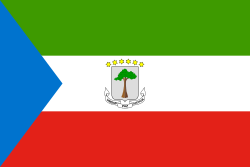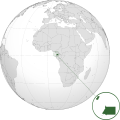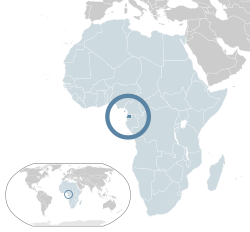Equatorial Guinea
The Republic of Equatorial Guinea is a nation in west central Africa, and one of the smallest countries in Africa. It borders Cameroon on the north, Gabon on the south and east, and the Gulf of Guinea on the west. The country's territory is both on the continent and on islands. The continental part is known as Río Muni. On one island, Bioko, is the capital, Malabo.
Republic of Equatorial Guinea República de Guinea Ecuatorial (in Spanish) République de Guinée équatoriale (in French) República da Guiné Equatorial (in Portuguese) Repubblica della Guinea Equatoriale (in Italian) | |
|---|---|
| Motto: | |
| Anthem: | |
 Location of Equatorial Guinea (dark blue) – in Africa (light blue & dark grey) | |
| Capital | Malabo 3°45′N 8°47′E / 3.750°N 8.783°E |
| Official languages | Spanish French Portuguese |
| Spanish (administrative) | |
| Ethnic groups (1994[1]) | 85.7% Fang 6.5% Bubi 3.6% Mdowe 1.6% Annobon 1.1% Bujeba 1.4% other (Spanish) |
| Demonym(s) | Equatoguinean, Equatorial Guinean |
| Government | Unitary presidential republic |
| Teodoro Obiang Nguema Mbasogo | |
| Manuel Osa Nsue Nsua | |
| Independence | |
• from Spain | 12 October 1968 |
| Area | |
• Total | 28,050 km2 (10,830 sq mi) (144th) |
• Water (%) | negligible |
| Population | |
• 2009 estimate | 676,000[2] (166th) |
• Density | 24.1/km2 (62.4/sq mi) (187th) |
| GDP (PPP) | 2010 estimate |
• Total | $24.146 billion[3] |
• Per capita | $34,824[3] (22nd) |
| GDP (nominal) | 2010 estimate |
• Total | $14.006 billion[3] |
• Per capita | $20,200[3] |
| HDI (2010) | low · 117th |
| Currency | Central African CFA franc (XAF) |
| Time zone | UTC+1 (WAT) |
• Summer (DST) | UTC+1 (not observed) |
| Driving side | right |
| Calling code | 240 |
| ISO 3166 code | GQ |
| Internet TLD | .gq |
a. Including Equatoguinean Spanish (Español ecuatoguineano). | |
Equatorial Guinea and the peoples living there were colonized by Spain. Spanish is an official language because of this.[5]
Provinces
Equatorial Guinea is divided into eight provinces (capitals appear in parentheses):
- Annobón (San Antonio de Palé)
- Bioko Norte (Malabo)
- Bioko Sur (Luba)
- Centro Sur (Evinayong)
- Djibloho (Ciudad de la Paz)
- Kié-Ntem (Ebebiyín)
- Litoral (Bata)
- Wele-Nzas (Mongomo)
The provinces are further divided into districts.
Equatorial Guinea Media
Equatorial Guinea's national anthem, performed by the United States Navy Band
Portuguese rule in Equatorial Guinea lasted from the arrival of Fernão do Pó (Fernando Pó) in 1472 until the 1778 Treaty of El Pardo
Map of the Spanish possessions in 1897, before the Treaty of Paris (1900)
Borders after the agreement of 1900 on the land that would become Spanish Guinea, until the independence of 1968
Guardia Civil and Marine Infantry in Spanish Guinea in 1964
References
- ↑ "Cia World Factbook; Equatorial Guinea". Archived from the original on 2020-08-31. Retrieved 2009-06-03.
- ↑ Department of Economic and Social Affairs Population Division (2009). "World Population Prospects, Table A.1" (PDF). 2008 revision. United Nations. Retrieved 2009-03-12.
{{cite journal}}: Cite journal requires|journal=(help) - ↑ 3.0 3.1 3.2 3.3 World Development Indicators database, World Bank, accessed on 23 August 2011.
- ↑ "Human Development Report 2009. Human development index trends: Table G" (PDF). United Nations. January 2009. Retrieved 2009-10-10.
- ↑ Sundiata, Ibrahim K. (1990). Equatorial Guinea : colonialism, state terror, and the search for stability. Boulder, Colorado: Westview Press. pp. 38–41. ISBN 0-8133-0429-6. OCLC 15860090.
Other websites
![]() Media related to Equatorial Guinea at Wikimedia Commons
Media related to Equatorial Guinea at Wikimedia Commons









